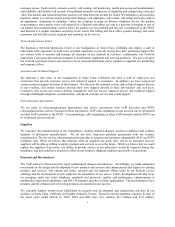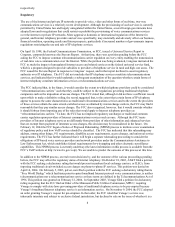8x8 2005 Annual Report Download - page 20
Download and view the complete annual report
Please find page 20 of the 2005 8x8 annual report below. You can navigate through the pages in the report by either clicking on the pages listed below, or by using the keyword search tool below to find specific information within the annual report.17
For arrangements with multiple obligations (for example, undelivered maintenance and support), we allocate
revenue to each component of the arrangement using the residual value method based on the fair value of the
undelivered elements, which is specific to us. This means that we defer revenue from the arranged fee that is
equivalent to the fair value of the undelivered elements. Fair values for the ongoing maintenance and support
obligations for our technology licenses are based upon separate sales of renewals to other customers or upon renewal
rates quoted in the contracts. We base the fair value of services, such as training or consulting, on separate sales of
these services to other customers. We recognize revenue for maintenance services ratably over the contract term.
Our training and consulting services are billed based on hourly rates and we generally recognize revenue as these
services are performed.
If a software license arrangement includes acceptance criteria, revenue is not recognized until we can objectively
demonstrate that the software or service can meet the acceptance criteria or when the customer has signed formal
acceptance documentation. If a software license arrangement obligates us to deliver unspecified future products,
revenue is recognized on a subscription basis, ratably over the term of the contract.
For all sales, except those completed via the Internet, we use either a binding purchase order or other signed
agreement as evidence of an arrangement. For sales over the Internet, we use a credit card authorization as evidence
of an arrangement, and recognize revenue upon settlement of the transaction, if there are no customer acceptance
conditions. We do not settle credit card transactions until equipment related to the transaction, if any, is shipped to a
customer.
Our ability to enter into revenue generating transactions and recognize revenue in the future is subject to a number
of business and economic risks discussed below under "Factors that May Affect Future Results."
Collectibility of Accounts Receivable
We must make estimates of the collectibility of our accounts receivable. Management specifically analyzes accounts
receivable, including historical bad debts, customer concentrations, customer creditworthiness, current economic
trends and changes in our customer payment terms when evaluating the adequacy of the allowance for doubtful
accounts. The accounts receivable balance approximated $1.1 million, net of an allowance for doubtful accounts of
$68,000 as of March 31, 2005, including a reserve for disputed credit card charges. If the financial condition of our
customers were to deteriorate, our actual losses may exceed our estimates, and additional allowances would be
required.
Valuation of Inventories
We write down our inventory for estimated obsolescence or unmarketable inventory equal to the difference between
the cost of inventory and the estimated market value based upon assumptions about future demand, market
conditions and replacement costs. If actual future demand or market conditions are less favorable than those
projected by us, additional inventory write-downs may be required.
Income Taxes
As part of the process of preparing our consolidated financial statements we are required to estimate our income
taxes in each of the jurisdictions in which we operate. This process involves us estimating our actual current tax
expense together with assessing temporary differences resulting from differing treatment of items, such as deferred
revenue, for tax and accounting purposes. These differences result in deferred tax assets and liabilities, which are
included within our consolidated balance sheet. We must then assess the likelihood that our deferred tax assets will
be recovered from future taxable income and to the extent we believe that recovery is not likely, we must establish a
valuation allowance. In the event that we determine that we would be able to realize deferred tax assets in the future
in excess of the net recorded amount, an adjustment to the deferred tax asset would increase income in the period
such determination was made.
Significant management judgment is required in determining the valuation allowance recorded against our net
deferred tax assets, which primarily consist of net operating loss and tax credit carry forwards. We have recorded a
valuation allowance of $60.9 million as of March 31, 2005, due to uncertainties related to our ability to utilize most
of our deferred tax assets before they expire. The valuation allowance is based on our estimates of taxable income
by jurisdiction in which we operate and the period over which our deferred tax assets will be recoverable.
























